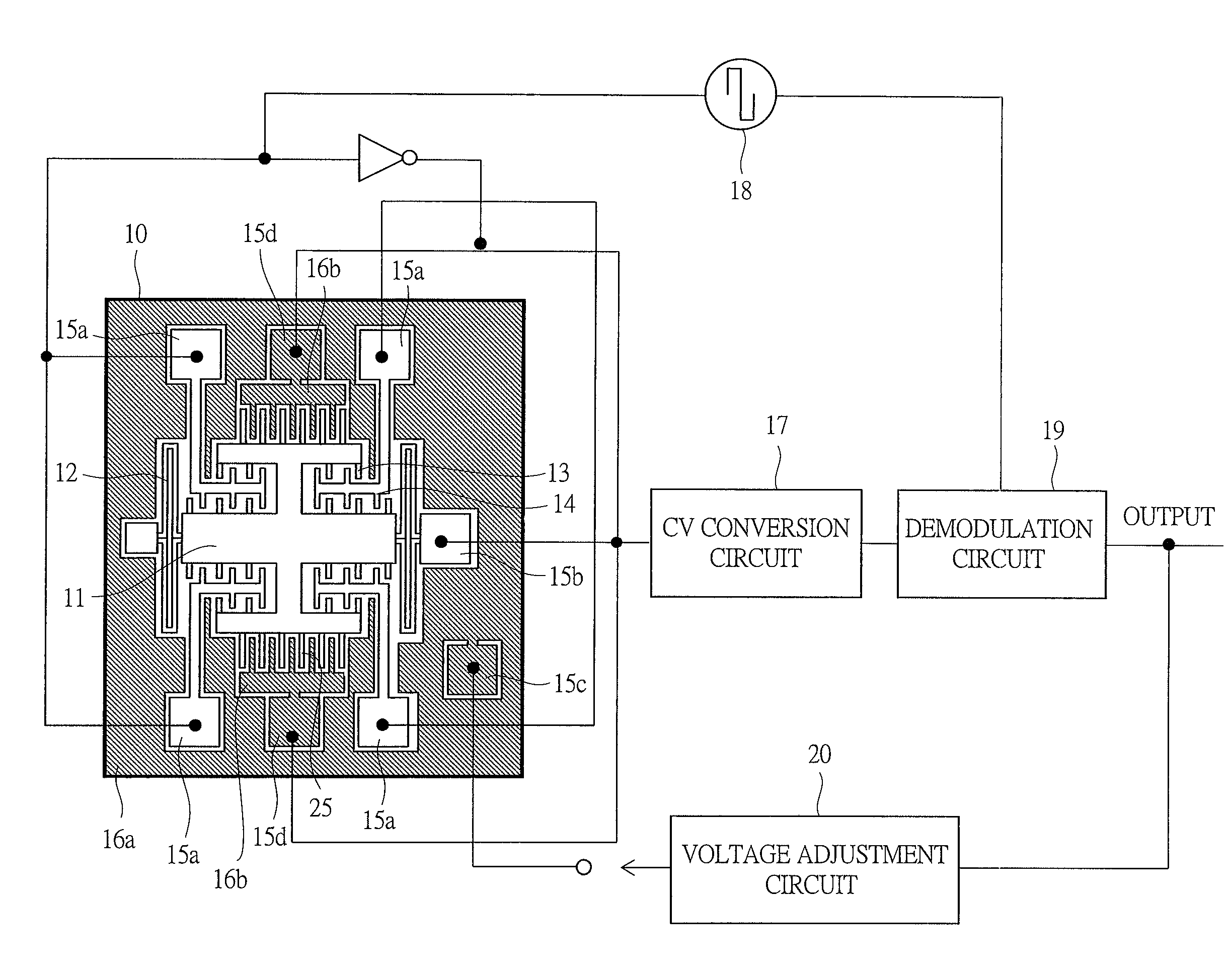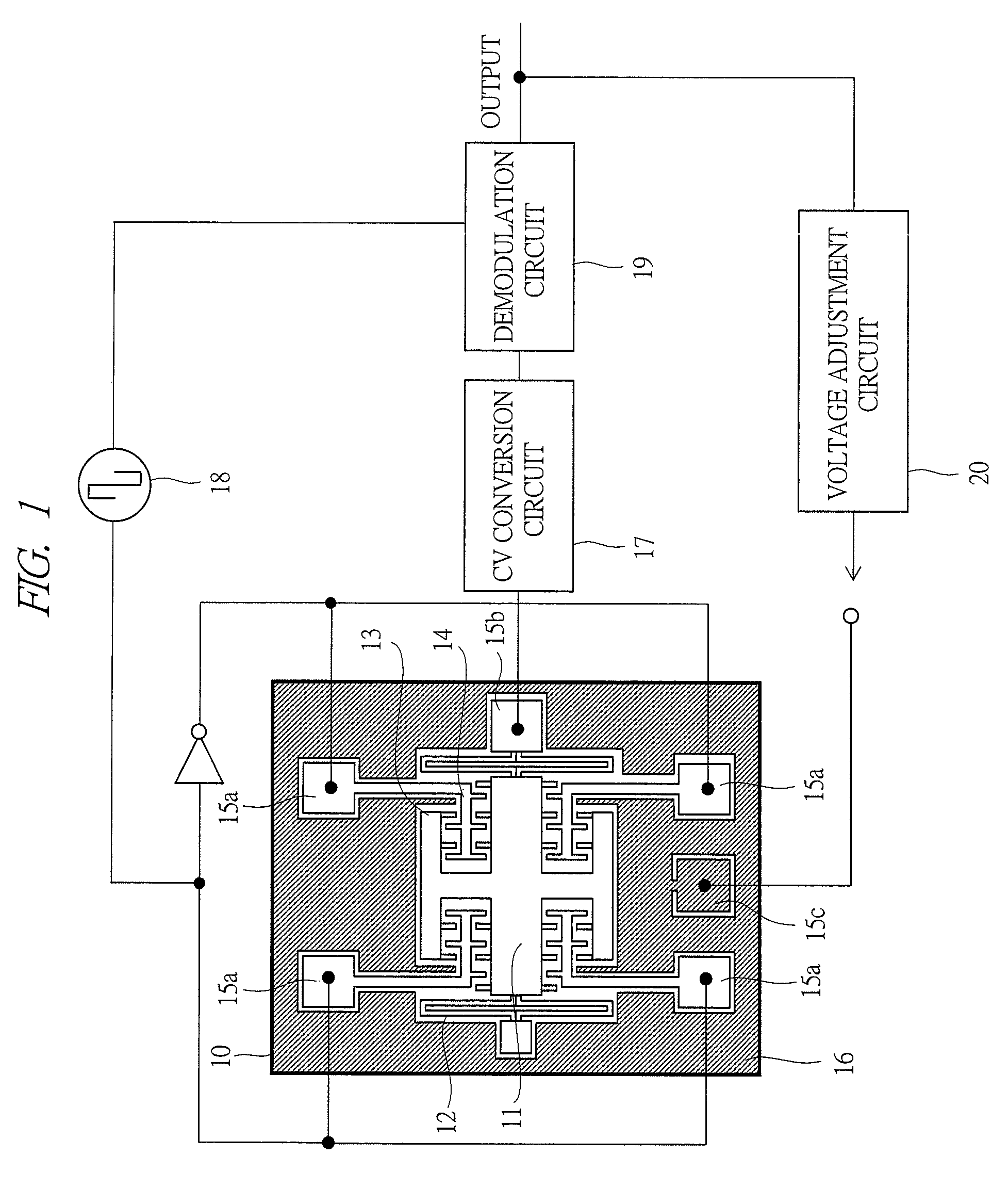Inertial sensor
a sensor and inertial sensor technology, applied in the field ofinertial sensors, to achieve the effect of suppressing fixation, suppressing the s/n ratio reduction of the sensor output and offset occurren
- Summary
- Abstract
- Description
- Claims
- Application Information
AI Technical Summary
Benefits of technology
Problems solved by technology
Method used
Image
Examples
first embodiment
[0046]FIG. 1 shows a schematic diagram of a chip overview and wiring of an acceleration sensor according to a first embodiment of the present invention.
[0047]The acceleration sensor serving as an inertial sensor according to the first embodiment comprises: a sensor chip 10; a capacitance / voltage (CV) conversion circuit 17 serving as a detection circuit; a carrier-wave application circuit 18; a demodulation circuit 19; a voltage adjustment circuit 20 serving as a control circuit; and others. An inertial mass 11, supporting beam structures 12 of the inertial body, movable electrodes 13 and fixed electrodes 14 for detecting the travel distance of the inertial body, and pad patterns 15a to 15c for connecting the sensor chip 10 with detection circuit elements are formed on the sensor chip 10. In addition, a peripheral conductor 16 is provided so as to surround the peripheries of these sensor constituent elements. Further, the fixed electrodes 14 are provided to face the movable electrode...
second embodiment
[0057]FIG. 4 shows a schematic diagram of a chip overview and wiring of an acceleration sensor according to a second embodiment of the present invention.
[0058]The acceleration sensor serving as an inertial sensor according to the second embodiment comprises: the sensor chip 10; the capacitance / voltage (CV) conversion circuit 17 serving as a detection circuit; the carrier-wave application circuit 18; the demodulation circuit 19; the voltage adjustment circuit 20 serving as a control circuit; and others. The inertial mass 11, the supporting beam structures 12 of the inertial body, the movable electrodes 13 and the fixed electrodes 14 for detecting the travel distance of the inertial body, restriction means 25 which restricts the operation of the acceleration sensor, and pad patterns 15a to 15d for connecting the sensor chip 10 with detection circuit elements are formed on the sensor chip 10. In addition, the peripheral conductors 16a and 16b are provided so as to surround the peripher...
third embodiment
[0068]FIG. 7 shows a chip overview and wiring of an acceleration sensor according to a third embodiment of the present invention.
[0069]The acceleration sensor serving as an inertial sensor according to the third embodiment comprises: the sensor chip 10; the capacitance / voltage (CV) conversion circuit 17 serving as a detection circuit; the carrier-wave application circuit 18; the demodulation circuit 19; the voltage adjustment circuit 20 serving as a control circuit; and others. The inertial mass 11, the supporting beam structures 12 of the inertial body, the movable electrodes 13 and the fixed electrodes 14 for detecting the travel distance of the inertial body, and pad patterns 15a to 15c and 15e for connecting the sensor chip 10 with detection circuit elements are formed on the sensor chip 10. Also, the conductor 16 is provided so as to surround the peripheries of these sensor constituent elements. When acceleration is applied to the sensor, the inertial mass 11 is displaced in th...
PUM
 Login to View More
Login to View More Abstract
Description
Claims
Application Information
 Login to View More
Login to View More - R&D
- Intellectual Property
- Life Sciences
- Materials
- Tech Scout
- Unparalleled Data Quality
- Higher Quality Content
- 60% Fewer Hallucinations
Browse by: Latest US Patents, China's latest patents, Technical Efficacy Thesaurus, Application Domain, Technology Topic, Popular Technical Reports.
© 2025 PatSnap. All rights reserved.Legal|Privacy policy|Modern Slavery Act Transparency Statement|Sitemap|About US| Contact US: help@patsnap.com



